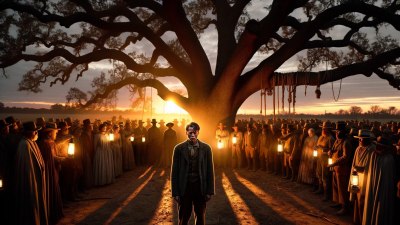The Vengeance of a Tree (Ghost Story)
A small town is shaken by a gruesome murder. Walter Stedman, a laborer from the city, finds himself wrongfully accused of killing his employer’s daughter, Margaret Kelsey, despite his innocence...
 Eleanor F. Lewis
Eleanor F. Lewis 
This image was created with the assistance of DALL·E
Through the windows of Jim Daly’s saloon, in the little town of C----, the setting sun streamed in yellow patches, lighting up the glasses scattered on the tables and the faces of several men who were gathered near the bar. Farmers mostly they were, with a sprinkling of shopkeepers, while prominent among them was the village editor, and all were discussing a startling piece of news that had spread through the town and its surroundings. The tidings that Walter Stedman, a laborer on Albert Kelsey’s ranch, had assaulted and murdered his employer’s daughter, had reached them, and had spread universal horror among the people.
A farmer declared that he had seen the deed committed as he walked through a neighboring lane, and, having always been noted for his cowardice, instead of running to the girl’s aid, had hailed a party of miners who were returning from their mid-day meal through a field near by. When they reached the spot, however, where Stedman (as they supposed) had done his black deed, only the girl lay there, in the stillness of death. Her murderer had taken the opportunity to fly. The party had searched the woods of the Kelsey estate, and just as they were nearing the house itself the appearance of Walter Stedman, walking in a strangely unsteady manner toward it, made them quicken their pace.
He was soon in custody, although he had protested his innocence of the crime. He said that he had just seen the body himself on his way to the station, and that when they had found him he was going to the house for help. But they had laughed at his story and had flung him into the tiny, stifling calaboose of the town.
What were their proofs? Walter Stedman, a young fellow of about twenty-six, had come from the city to their quiet town, just when times were at their hardest, in search of work. The most of the men living in the town were honest fellows, doing their work faithfully, when they could get it, and when they had socially asked Stedman to have a drink with them, he had refused in rather a scornful manner. “That infernal city chap,” he was called, and their hate and envy increased in strength when Albert Kelsey had employed him in preference to any of themselves. As time went on, the story of Stedman’s admiration for Margaret Kelsey had gone afloat, with the added information that his employer’s daughter had repulsed him, saying that she would not marry a common laborer. So Stedman, when this news reached his employer’s ears, was discharged, and this, then, was his revenge! For them, these proofs were sufficient to pronounce him guilty.
Yet that afternoon, as Stedman, crouched on the floor of the calaboose, grew hopeless in the knowledge that no one would believe his story, and that his undeserved punishment would be swift and sure, a tramp, boarding a freight car several miles from the town, sped away from the spot where his crime had been committed, and knew that forever its shadow would follow him.
From the tiny window of his prison Walter Stedman could see the red glow of the heavens that betokened the setting of the sun. So the red sun of his life was soon to set, a life that had been innocent of all crime, and that now was to be ended for a deed that he had never committed. Most prominent of all the visions that swept through his mind was that of Margaret Kelsey, lying as he had first found her, fresh from the hands of her murderer. But there was another of a more tender nature. How long he and Margaret had tried to keep their secret, until Walter could be promoted to a higher position, so that he could ask for her hand with no fear of the father’s antagonism! Then came the remembrance of an afternoon meeting between the two in the woods of the Kelsey estate--how, just as they were parting, Walter had heard footsteps near them, and, glancing sharply around, saw an evil, scowling, murderous face peering through the brush. He had started toward it, but the owner of the countenance had taken himself hurriedly off.
The gossiping townspeople had misconstrued this romance, and when Albert Kelsey had heard of this clandestine meeting from the man who was later on to appear as a leader of the mob, and that he had discharged Stedman, they had believed that the young man had formally proposed and had been rejected. But justice had gone wrong, as it had done innumerable times before, and will again. An innocent man was to be hanged, even without the comfort of a trial, while the man who was guilty was free to wander where he would.
That autumn night the darkness came quickly, and only the stars did their best to light the scene. A body of men, all masked, and having as a leader one who had ever since Stedman’s arrival in town, cherished a secret hatred of the young man, dragged Stedman from the calaboose and tramped through the town, defying all, defying even God himself. Along the highway, and into Farmer Brown’s “cross cut,” they went, vigilantly guarding their prisoner, who, with the lanterns lighting up his haggard face, walked among them with the lagging step of utter hopelessness.
“That’s a good tree,” their leader said, presently, stopping and pointing out a spreading oak; when the slipknot was adjusted and Stedman had stepped on the box, he added: “If you’ve got anything to say, you’d better say it now.”
“I am innocent, I swear before God,” the doomed man answered; “I never took the life of Margaret Kelsey.”
“Give us your proof,” jeered the leader, and when Stedman kept a despairing silence, he laughed shortly.
“Ready, men!” he gave the order. The box was kicked aside, and then--only a writhing body swung to and fro in the gloom.
In front of the men stood their leader, watching the contortions of the body with silent glee. “I’ll tell you a secret, boys,” he said suddenly. “I was after that poor murdered girl myself. A d---- little chance I had; but, by ----, he had just as little!”
A pause--then: “He’s shunted this earth. Cut him down, you fellows!”
*
“It’s no use, son. I’ll give up the blasted thing as a bad job. There’s something queer about that there tree. Do you see how its branches balance it? We have cut the trunk nearly in two, but it won’t come down. There’s plenty of others around; we’ll take one of them. If I’d a long rope with me I’d get that tree down, and yet the way the thing stands it would be risking a fellow’s life to climb it. It’s got the devil in it, sure.”
So old Farmer Brown shouldered his axe and made for another tree, his son following. They had sawed and chopped and chopped and sawed, and yet the tall white oak, with its branches jutting out almost as regularly as if done by the work of a machine, stood straight and firm.
Farmer Brown, well known for his weak, cowardly spirit, who in beholding the murder of Albert Kelsey’s daughter, had in his fright mistaken the criminal, now in his superstition let the oak stand, because its well-balanced position saved it from falling, when other trees would have been down. And so this tree, the same one to which an innocent man had been hanged, was left--for other work.
It was a bleak, rainy night--such a night as can be found only in central California. The wind howled like a thousand demons, and lashed the trees together in wild embraces. Now and then the weird “hoot, hoot!” of an owl came softly from the distance in the lulls of the storm, while the barking of coyotes woke the echoes of the hills into sounds like fiendish laughter.
In the wind and rain a man fought his path through the bush and into Farmer Brown’s “cross cut,” as the shortest way home. Suddenly he stopped, trembling, as if held by some unseen impulse. Before him rose the white oak, wavering and swaying in the storm.
“Good God! it’s the tree I swung Stedman from!” he cried, and a strange fear thrilled him.
His eyes were fixed on it, held by some undefinable fascination. Yes, there on one of the longest branches a small piece of rope still dangled. And then, to the murderer’s excited vision, this rope seemed to lengthen, to form at the end into a slipknot, a knot that encircled a purple neck, while below it writhed and swayed the body of a man!
“Damn him!” he muttered, starting toward the hanging form, as if about to help the rope in its work of strangulation; “will he forever follow me? And yet he deserved it, the black-hearted villain! He took her life----”
He never finished the sentence. The white oak, towering above him in its strength, seemed to grow like a frenzied, living creature. There was a sudden splitting sound, then came a crash, and under the fallen tree lay Stedman’s murderer, crushed and mangled.
From between the broken trunk and the stump that was left, a gray, dim shape sprang out, and sped past the man’s still form, away into the wild blackness of the night.
👻
This story is part of "Twenty-Five Ghost Stories" by W. Bob Holland. Read all the stories from this enchanting collection HERE!
✍✍✍
The story you've just experienced is a work of fiction, a creation of the imagination meant to entertain, provoke thought, and inspire. From the heart-fluttering highs of love stories to the spine-tingling chills of horror, these stories are unbound by the mundane. Whether you're in the mood for a quick escape or a deep dive into fantastical realms, explore the place where imagination echoes beyond the ordinary - Echoes of Imagination!



















